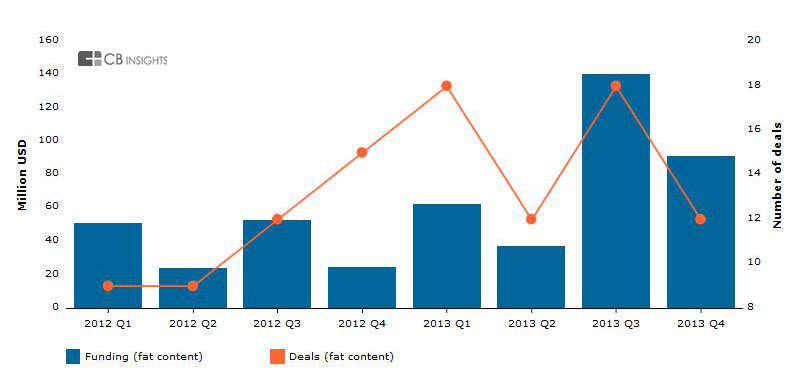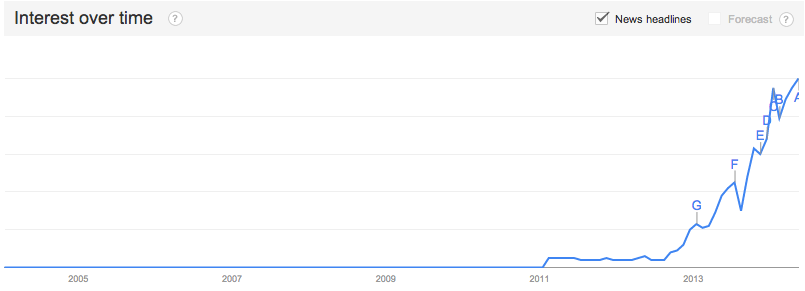Taylor Davidson · Publishing as a Product, Pageviews as Users, and What The Shift Means
I’ve been thinking a lot about content publishing lately, but I’m not the only one. Venture investment is flowing into publishing, to the tune of $330 MM over 2013, up 117% over the previous year, and it’s driven by a range of early and later-stage financings (data below from CB Insights):
Big investments into Buzzfeed ($46 MM), Vox Media ($80 MM), Business Insider ($30 MM), Cheezburger ($37 MM), Sugar ($46 MM) and others may have stolen the headlines, but there’s a range of other interesting fundings in the content space, including Medium ($25 MM), Upworthy ($12 MM), Gawker, Skift ($1.5 MM), PolicyMic ($3 MM), Circa ($1.65 MM), notably for their technology, mix of creation and curation, and differing views towards usage metrics. Clicks may be an efficient business model for advertisements, but for measuring the performance of content, clicks may not measure what publishers count as “success”.
Of course, what does “success” mean for a content publisher? It’s not an easy answer, as pageviews, clicks, and pure traffic measures do not capture the full business goals of a publisher, which may include many different businesses ranging from ads, subscriptions, apps, conferences, data, and other physical and digital products. For news organizations, the data is an input, but it’s not necessarily used to guide editorial content. Real life and world events, and the broader brand goals of the news organization, may trump pure clicks and pageviews. The Economist, Wall Street Journal and NY Times, for example, have broader business goals that a chase for clicks and pageview-driven ad revenues simply can’t serve.
The insufficiency of clicks and pageviews as metrics of holistic business success is one reason that publishers like Medium and Upworthy are measuring attention instead of clicks, focusing on total time reading and attention minutes instead.
But new “attention” metrics aren’t what make Medium, Upworthy and others compelling as new publishers: what’s more interesting is how they’re built differently to think about publishing as a product and readers as users. In a web seemingly ruled by social networks, building a next-gen publisher isn’t just about creating the “flywheel” of user-generated content, it’s also about understanding the users themselves at a level traditional publishers simply aren’t architected to do.
Josh Schwartz of Chartbeat recently made the argument at an event hosted by NYC’s Media Lab that metrics should be geared more toward audience retention than pageviews. He showed data that demonstrated that the sources of spikes in pageviews don’t yield return readers, and that reader retention can modeled based on where they came from (referral source matters), how long of an article they read, what time they visited, and more. Modeling users, he pointed out, is easier than modeling the performance of content.
Any data-driven publisher has their own method for measuring and predicting content performance and viral potential, and using that data to refine their editorial content. For example, Buzzfeed will change editorial content in listicles after seeing how the content performs after an hour. Upworthy uses a rigorous A/B testing approach to optimize their content for attention and sharing, testing headlines, share images, and more. They’re the obvious ones, but they aren’t the only ones paying attention to viral math; as I wrote about earlier, other publishers like Viral Nova, Elite Daily, Thought Catalog and others are winning at sharing because they pay attention to metrics. And let’s not forget that the rise of content creation companies like NewsCred ($46 MM in venture funding), Contently ($12 MM), Percolate ($35 MM) and others to help brands create and publish content (ranging from long- to short-form across the companies mentioned) are creating new publishers using intensely data-driven approaches.
That attention to data-driven analysis can be infused into any organization, but managing it and utilizing the data efficiently takes investments in new tech. Vox, Gawker, PolicyMic are examples from the new breed of publishers that built technology for their writers and editors to effectively create and monitor the performance of content. And let’s not forget that publishers like Medium and Circa are technology companies first, publishers second, because they approach content as a product first and foremost.
Medium is interesting for a couple of things: for one, the heritage of its founders, but also how they are approaching building a new publisher. It’s a blend between a user-generated content site and a curated, editorial site where some writers get paid, to media companies utilizing the platform to tap into Medium’s audience, to brands creating content hubs in a manner that’s a mix between a channel on Huffington Post and a page on Twitter.
Recently Medium launched the ability to embed Medium posts, profiles and collections onto external sites. I’m speculating, but I don’t think this is about alleviating user SEO issues around cross-posting, but a larger strategy that applies the ideas from Twitter and Google “cards” that bolsters their desktop and mobile product and creates a better offering for brands. In the long run, I also think this is the start of a paid media promotion play, but there’s a way to go from here to there.
Many publishers have pinned their hopes on “native advertising” to be their savior to combat the decline in effectiveness of banner advertisements, by creating new ad units and flexible content that will perform better because they are more in line with a user’s experience with the site.
The increased interest in native advertising is real…
… but it’s misplaced. Native advertising isn’t a savior, it’s merely a new ad unit that will be managed, optimized, refined, and evenutally bought and sold, like all other ad units. Native ads aren’t better because they’re native to the experience or don’t look like ads, they’re better because they’re more customized and relevant, and that will be powered by better data about who are viewing them. Additionally, native advertising will become programmatic faster than anyone realizes, and success at programmatic advertising takes a deep understanding of impression-level data about the person viewing an impression so that an ad can be optimized, delivered, and priced appropriately. And that takes an understanding of users that few publishers are able to currently deliver.
But let’s go back to thinking about thinking about users instead of pageviews. Traditional publishers depend on Omniture, Google Analytics, comScore, Quantcast, Nielson and a host of other analytics companies large and small to determine the performance of their sites and to determine who is reading their content. Audience analytics providers build segments and profiles of readers to create demographic, attitudinal and other measurements to figure out who visits their site, but there’s two important gaps: 1) they focus on audience and not individual users, and 2) they focus on who we are instead of what we want.
Back in 2011 I wrote about how social services are “intent engines” that capture massive amounts of data about not just who we are but what we want, and about how this intent data was more important than demographic data.
Publishers are sitting on a goldmine, but only if they have the tools to mine the gold of first-party user and intent data created by how people use their sites. Publishers have attempted to push people to create registered user accounts, but because the user utility is traditionally very limited, it’s hardly been something that people value and that publishers have leveraged. Publishers have often depended on third-party identity services (Facebook Connect, Twitter or Google signin) or social utility plugins (AddThis, ShareThis, Gigya, Livefyre, Disqus) to power user login, sharing, commenting, and audience tools, but the dependence on third-parties has hollowed out the bottom-line of publishers by “extracting the data about publishers’ users without giving them the tools to understand their users and price their ads effectively”. Compare that to social publishers such as Facebook, Twitter, LinkedIn, and a host of other user-generated content sites that have extensive first-party information about their users.
Of course, owned user data isn’t just about ads, it’s also about delivering a better product. Owned user data can inform platform direction, personalization, and a range of services outside of just content. The re-architecting of publishers is driven by a number of factors, including the rise of streams of content, rather than web pages, the shift of attention to social networks, the increasing use of mobile devices, the rise of programmatic ad buying and selling, the increasing competition from user-generated content and brands, the blend between content and commerce, and a number of other factors shaping the nature of journalism, news, and publishing. Marc Andreessen recently got a lot of press and criticism for his analysis of the news business, much of it for his assertion that:
The big opportunity for the news industry in the next 5 to 10 years is to increase its market size 100x AND drop prices 10X.
That may seem unfathomable for existing traditional publishers that are based on a “content is king” model that has real challenges in revenues and costs of production, but given the massive scope of changes in how content is created, curated, and consumed, for newer publishers that build a business on a “user is king” (and queen) perspective, they may indeed capture the opportunity that Andreessen predicts and VCs are funding.

